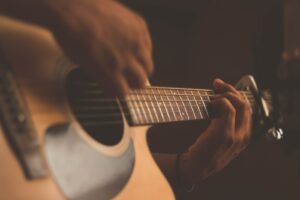Acoustic guitars are pretty popular among musical instrument lovers.
One of the most popular parts of an acoustic guitar is the bridge.
It is the narrow piece of wood on the acoustic guitar bolted into its body.
The typical function is to support the strings and transmits the sound vibration into the soundboard.
In simple terms, it amplifies the sound produced by the guitar sounds.
One of the current issues on acoustic guitar bridge is how it must be directed.
Which way does the bridge go on an acoustic guitar?
It depends on preference and taste. Some people prefer the bridge and saddle to be higher to get to the higher strings comfortably. As for other guitarists, they prefer the right side to access the lower strings comfortably.
Another condition is the angle of the bridge relative to your acoustic guitar.
The bridge angle relative to your acoustic guitar top depends on taste and preference. A shallow angle or closer to the top delivers a long scale length, while a steeper angle has a shorter length.
In both situations, you will produce two different kinds of sounds.
Which is the best depends on your guitar-playing style and the music genre you are playing.
Which End of a Guitar Bridge Is Higher?
Acoustic guitar bridge naturally slopes from bass to treble side.
Between these two slopes, which end of the guitar bridge is higher?
The treble side is usually on the higher side of the guitar neck, while the bass side is lifted slightly for smooth sound transmission.
However, most guitarists realize that the saddle bounded by the bridge works best when in the middle.
It produces more apparent music despite the sound you are trying to create.
What Is the Function of Bridges in Acoustic Guitars?
The information above shows that the bridge is crucial in acoustic guitars.
It is a vital part embodied in an acoustic guitar body.
So, what role does the bridge play in an acoustic guitar?
It Is Where the Strings Are Attached To A Guitar
One of the most essential characteristics of an acoustic guitar is that it is a strummed musical instrument.
It means that you have strings to strum to produce sound.
Learning the basic string combination to produce sound would be best.
The bridge is the wooded part on the larger side of your acoustic guitar.
One of its primary roles is to hold the strings in place as you play the guitar.
It helps in Transferring Vibrations from The Strings To The Soundboard
If you are new to playing the guitar, you have probably wondered how such an instrument produces such sound.
How can the string transmit the sound when you strum it?
The bridge in the acoustic guitar transfers these vibrations into the soundboard.
It ensures that every note you play is carefully transmitted in order into the soundboard.
Amplify The Sound Produced by The Strings
Generally, if you strum a few strings, you will likely produce sound vibration.
But, it isn’t clear or something people can make out as sound.
In an acoustic guitar, the bridge transfers the vibrations into the soundboard and acts like an amplifier.
It makes the sound louder and more precise.
With that, you can listen to the sound produced by an acoustic guitar.
In simple ways, a bridge in an acoustic guitar is similar to an amplifier.
Defines The Kind of Music You Produce
From the details above, it is clear that the bridge positioning is crucial to the sound your acoustic guitar produces.
Of course, different angles and positions may work, but the bridge position plays a significant role.
It defines the kind of music depending on its placement and angle.
As a result, many guitarists adjust their guitar bridge depending on their playing style and the music.
In that case, it is crucial to understand your playing style and the best bridge position to adopt.
Otherwise, you are likely to produce concerning sounds on your guitar.
Which Way Is the Bridge Pickup?
Bridge pickup is one of the most popular positions a guitarist can adopt.
The other central pickup is the neck position pickup.
The two pickups are different and sound different.
Bridge pickup, also known as the 1st position, is wired on the pickup selector’s leftmost area or the low position.
It is typically the first standard position that many guitarists play.
Generally, the bridge pickup is louder and brighter when producing sound.
By that, the sound is more focused and has more strength.
The bridge pickup is better for rock music than blues and jazz.
You use acoustic-like guitar strumming in acoustic guitars, meaning you prefer to work in the in-between positions.
The neck pickup works better in acoustic guitar since you get a balanced-out sound that is neither loud nor silent.
In other words, you get a warm tone that works well with several music genres.
Which Way Should the Acoustic Guitar Face?
The most basic lesson in guitar playing is appropriately holding the guitar.
Unfortunately, many struggle with these basics, leading to terrible guitar-playing experiences.
Which way should the guitar face?
Generally, your guitar strings need to face the people.
It would be best not to turn the strings to look or face you.
This fact may surprise many newbies since it feels easier to play the guitar when you see the strings.
But this movement is bad for your left hand, and the guitar neck must elevate at a slight angle.
With that, it is easier to hold and play your guitar.
Besides, you can produce high-quality and clear sound.
Here are a few other pointers when holding your guitar:
Ensure that you sit or stand up straight
Let the guitar strings face the crowd
Elevate the guitar neck slightly to maintain a comfortable position
Place the right arm over the acoustic guitar edge
If you are using a guitar strap, ensure it is well-positioned to keep you comfortable and the guitar well-placed.
Is The Bridge Important in an Acoustic Guitar?
Yes! The bridge is vital in an acoustic guitar.
It is where the guitar strings are attached, and it transfers string vibrations into the soundboard.
Also, it is the amplifier of the acoustic guitar.
References
https://www.quora.com/Which-side-of-the-guitar-bridge-should-be-higher
https://www.levelsforguitar.com/how-to-hold-a-guitar-guitar-string-names-and-perform-tuning




